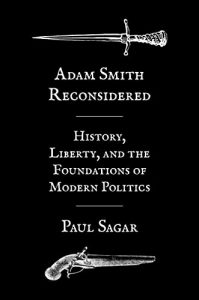In Adam Smith Reconsidered: History, Liberty, and the Foundations of Modern Politics, Paul Sagar offers a new appraisal of the work of the influential economist and moral philosopher Adam Smith, retrieving Smith’s legacy from simplistic readings to show him as a complex thinker whose work matured, developed and shifted across his life. Anyone interested in Adam Smith or the history of political ideas should read this book, recommends Jake Scott.
Adam Smith Reconsidered: History, Liberty, and the Foundations of Modern Politics. Paul Sagar. Princeton UP. 2022.
Find this book (affiliate link):![]()
 In a well-known essay from 1969, Quentin Skinner argued that a full reading of a theorist or writer’s work must be undertaken to understand the full scope of their argument. Writing that ‘it may be (and indeed it very often happens) that a given classic writer is not altogether consistent, or even that he fails altogether to give any systematic account of his beliefs’, Skinner urged historians of ideas to consider ‘the whole corpus’ to dispel any notion of the ‘mythology of coherence’ that a thinker may lack but which later biographers might conjure. If this is the mark of a good book, then Paul Sagar’s Adam Smith Reconsidered is nothing short of brilliant.
In a well-known essay from 1969, Quentin Skinner argued that a full reading of a theorist or writer’s work must be undertaken to understand the full scope of their argument. Writing that ‘it may be (and indeed it very often happens) that a given classic writer is not altogether consistent, or even that he fails altogether to give any systematic account of his beliefs’, Skinner urged historians of ideas to consider ‘the whole corpus’ to dispel any notion of the ‘mythology of coherence’ that a thinker may lack but which later biographers might conjure. If this is the mark of a good book, then Paul Sagar’s Adam Smith Reconsidered is nothing short of brilliant.
In many ways picking up where his previous work, The Opinion of Mankind, finished, Adam Smith Reconsidered is an exceptional attempt, following Skinner’s advice, to engage with the whole body of Smith’s work, whilst taking heed of his warning to not force coherence. Yet the primary goal of this book, laid out in the introduction, is to present a more accurate reflection of Smith’s work than prevails in the current literature. Importantly, Sagar achieves this by doing exactly what Skinner suggests. Indeed, as he writes in the opening to Chapter Five, ‘we must take a deeper look at what appears familiar’.
Each chapter engages with prevailing myths and, interestingly, in different ways. Laying out in the introduction the difference between ‘Das Adam Smith Problem’ and what he calls ‘Das Real Adam Smith Problem’, Sagar states his mission clearly: to prove both ‘problems’ wrong. The first, the ‘traditional problem’, is the misunderstanding that Smith made some kind of volte face between his early work, especially The Theory of Moral Sentiments and his magnum opus, The Wealth of Nations.
The second, ‘more urgent problem’, is how a ‘first-rate moral philosopher like Smith’ could think that ‘morality was not fatally compromised by the existence of the kind of market-reliant society that he set out to not only understand and explain, but in various ways suggest could be improved’ (3). In other words, Sagar’s enterprise is to prove that Smith’s later works did not contradict his earlier theories, but rather elaborated and refined them.

Image Credit: Photo by K. Mitch Hodge on Unsplash
The book is structured with this in mind. Chapter One engages with Smith’s theory of ‘commercial society’ and the common mistakes – three, in total – made in the existing literature. These are the supposed vagueness with which Smith used ‘commercial society’; the concurrent way that commentators employ the term as ‘a rough synonym for a consumption-driven economy’; and its employment as a description for ‘what is now known as liberal capitalism’ (11).
What lurks behind these mistakes, however, is Sagar’s real target: a misunderstanding of Smith’s ‘Four Stages of History’ theory as both stadial and conjectural (15) – in other words, as an attempt to explain the actual progression of history through stages of development. The former is based on the incorrect presumption that Smith is attempting to explain how history has actually unfolded. Yet the reality is that the Four Stages schema ‘is explicitly invoked to imagine how a single, isolated human society would develop were it to progress peacefully, in conditions of sufficient resource abundance, and without external shocks’ (20, my emphasis).
The ‘Four Stages of History’ theory is, in other words, a thought experiment. Smith’s depiction of history is better understood as a catalogue of unexpected and contingent events. Sagar makes it very clear that ‘commercial society’ is not a product of modernity but a mode of being between states that is always a possibility within certain conditions that are by no means limited to modernity (ancient China is one example).
Importantly, this argument is put forward in Smith’s Lectures on Jurisprudence, which Sagar shows to be developed and matured in The Wealth of Nations ten years later. Here, Smith uses the terms ‘unnatural and retrograde’ to explain the development of European feudal-based societies, (largely) moving on from the Four Stages theory (27-28).
Again, Sagar shows a conscientious approach to the relationship between Smith’s works and how they developed, revealing what Smith meant by the ‘unexpected and contingent’ nature of European (and, by extension, wider global) history. The ‘relative geographic security’ of Attica allowed the emergence of the poleis, the ancient city-states on the Greek peninsula, hemmed in by mountain ranges. Yet, this is a highly contingent factor, not a universal one, that is ‘not predictable via any a priori model’, including Smith’s own (32).
Sagar closes Chapter One by pre-emptively dismissing any objections to his reading of The Wealth of Nations in which it may be claimed that Book V reintroduces a stadial analysis of history once more. As may be expected, Sagar shows with great detail that Smith employs a three stage theory of history only in the context of the defence of settled lands, and actually rules out stadial theories of history to understand economic, political or even full military matters (38).
Thus rescuing Smith’s ‘commercial society’ from misuse, Sagar shows that the term for Smith was actually highly technical and precise, not so clumsy as some assume. It relates specifically to ‘how the division of labour conditions the ways that individuals secure subsistence’ (49).
Having neatly distinguished Smith’s economic from political theory, Sagar turns in Chapter Two to understand what Smith actually meant by one of the terms most commonly attributed to him – ‘liberty’. Here, Sagar moves slowly and carefully, especially with ‘Smith’s published works never explicitly stating what he takes liberty to be’ (55).
Throughout the book, the spectre of Jean-Jacques Rousseau looms large; or, to be more accurate, the historic misreading of his and Smith’s relationship. Sagar is at pains to make clear that this was not the grand clash of intellects it is often thought to be. Indeed, at several points, and in Chapter Three especially, Sagar demonstrates that for Smith, much of Rousseau’s writing was little more than a Genevan gloss on a very Scottish, very old set of ideas: ‘when encountering Rousseau in the mid-1750s, the Scot would have registered the Genevan as a highly able, but very behind-the-curve, thinker’ (117). In reality, Smith’s main target in his moral system was not Rousseau, but the legacies of David Hume and Bernard Mandeville, to such an extent that Rousseau was just ‘collateral damage’ (124-25).
It was at this point in the book that I found myself slightly confused. As is to be expected, Sagar arrives at Smith’s famous addition to the theories of incentive and pride by distinguishing them from Rousseau’s. He argues that whilst Rousseau saw ‘vanity’ as inherently corrupting, Smith makes a subtle distinction between praise and praiseworthiness, the latter ‘required to secure the possibility of genuine virtue in a world where ethical practices and values were ultimately a function of deep-rooted conventions of social interaction’ (127, 131). Sagar shows that Smith’s conjectures on pride, praise and incentive were not responses to Rousseau but more accurately aimed at the more developed works of Hume.
Yet this is where the confusion lies: Sagar is at pains to show Smith’s connections with Thomas Hobbes-via-Hume and Mandeville elsewhere in this text, as well as where Rousseau errs in his understanding of amour propre (self-esteem found in the value of others) and amour de soi (self-esteem found in the value of oneself). Yet he does not connect Smith’s theory of pride to Hobbes’s. There may be strategic reasons for this or it may have been an issue of space and word count, but it struck me as odd that Hobbes is a major touchstone for Sagar elsewhere, yet not here.
However, this is a minor consideration in an extremely thorough and engaging book. Sagar’s writing is not only incisive, but eminently readable, offering doses of humour alongside penetrating analysis. In Chapter Four, for instance, Sagar goes into detailed discussion of Smith’s criticism of an obsession with the means of Utility over actual Utility, using an amusing and engaging anecdote of his own experience to criticise ‘retail therapy’ as a paradigmatic example of Smith’s feared obsession with the ‘mechanisms of happiness’ over happiness itself (174-76).
Perhaps one of Sagar’s more subtle achievements is to rescue Smith from the many politicians and thinkers who invoke his name as an excuse for greater market liberalisation, with Chapter Five explaining Smith’s fear of over-powerful and conspiratorial merchants. Speaking to a contemporary concern over growing, unresponsive mega-corporations but in a way that is neither preaching nor agenda-driven, Sagar makes clear that Smith was not a proponent of uninhibited wealth-hoarding. He was especially fearful of the ‘conspiracy of merchants’, from which Sagar takes this chapter’s heading (187). As Sagar writes towards the end of Chapter Five, ‘the picture that emerges of Smith’s final position is therefore altogether less sanguine than the still common depiction of him as a relatively blase believer in the inevitable conjunction of commerce with liberty, and the upwards progress of human civilisation powered by the benign engine of market exchange’ (209).
Sagar’s great success with this book is to retrieve Smith’s legacy from a flattened-down, overly simplistic reading of his work in the past, whether that is from those who champion his name or those who pass over it. Sagar shows that Smith was not a Whig, nor was he an unconscious supporter of the status quo, but rather a highly complex thinker whose works matured, developed and shifted across his life. This text is one that anyone interested in Adam Smith should read but, more importantly, all historians of political ideas, as we can all learn from Sagar’s sagacity.
Note: This review gives the views of the author, and not the position of the LSE Review of Books blog, or of the London School of Economics and Political Science. The LSE RB blog may receive a small commission if you choose to make a purchase through the above Amazon affiliate link. This is entirely independent of the coverage of the book on LSE Review of Books.








1 Comments